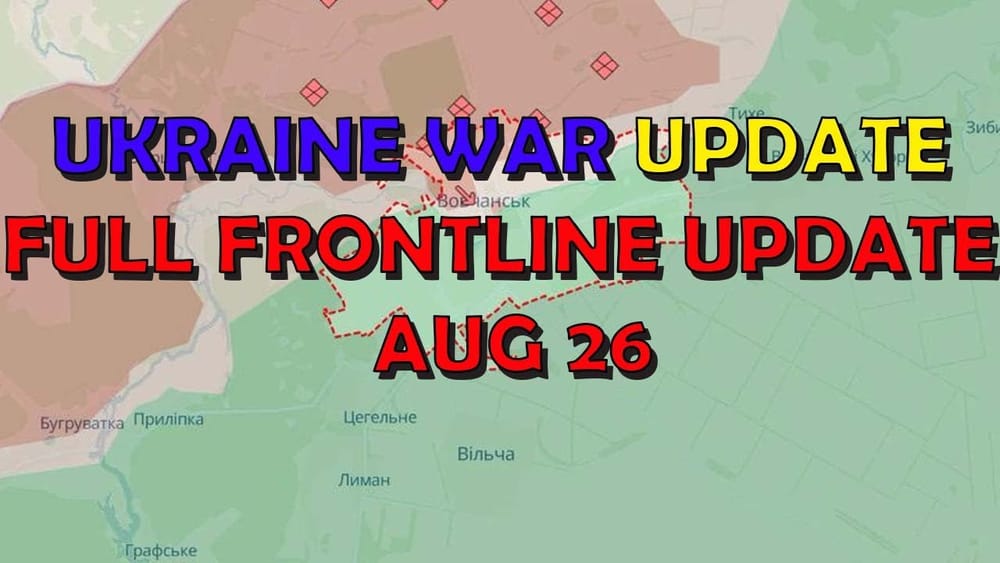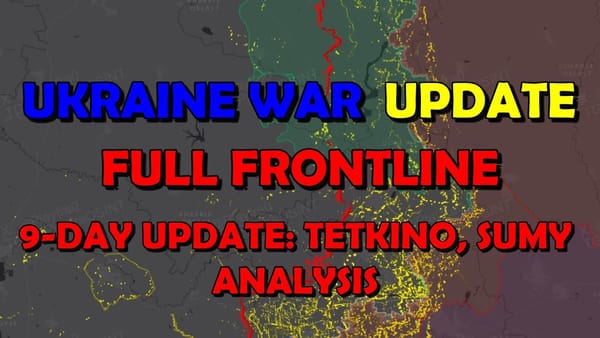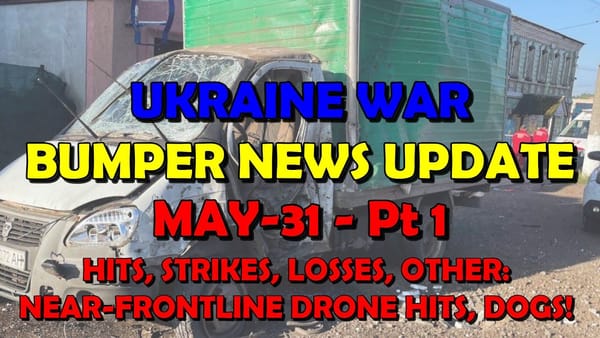Ukraine Conflict: Full Frontline Update
Table of Contents 📖
"Russia are just going to flatten it. Make of that what you will."
Hello Team
🎦 00:00-00:24⏩
Jonathan welcomes viewers to another frontline update, noting that this update is very late and covers a more extended period due to his holiday.
Return to top⤴️
📍 FRONT-LINE UPDATE -🗺️ MAP LEGEND

Mapping Sources and Updates
🎦 00:24-02:53⏩
Jonathan explains that he was unable to provide mapping updates for two and a half weeks due to his holiday. He outlines the mapping sources he's using:
- Blue lines represent updates from Andrew Perpetua's map, which he incorporated yesterday.
- The remaining lines, without pins, are from Syriac Maps, whose most recent updates he's integrated today.
Jonathan notes that Syriac Maps hasn't posted individual area updates today, suggesting a potential lack of changes from their perspective. He clarifies the colour scheme on the Syriac Maps layer, highlighting that the lighter shade of red (orangey-red) in occupied territories and the Kursk Oblast is simply an area of emphasis and holds no strategic significance. The crucial elements are:
- The red line signifying the Russian defensive line according to Syriac Maps.
- The blue line representing Andrew Perpetua's assessment of the Russian defensive line.
Jonathan points out a significant difference between the two maps around Malaya Lochnia, which he plans to discuss further. He also highlights discrepancies in the eastern area. He thanks JR for adding pins to indicate destroyed bridges.
Return to top⤴️
Kursk Oblast: Destroyed Bridges and Ukrainian Advance
🎦 02:53-11:37⏩
Jonathan directs attention to the Kursk Oblast, where JR has marked destroyed bridges on the map. He references Null Reports, mentioning the recent destruction of the third and final bridge across a river in the region near Kurchivka, leaving no road connections. He notes that while the Russians have set up a pontoon bridge, it has also reportedly been destroyed. Jonathan points out the area south of the river as a potential focus for a Ukrainian push, highlighting the possibility of advances from the east, south, and west. He discusses the vulnerability of Russian troops stranded on the western side of the river following the bridge destructions. He also analyzes Russian fortifications in the region, emphasizing the Ukrainians' ability to overcome existing defenses due to the element of surprise during the initial invasion. He notes that the Russians are now frantically constructing fortifications, particularly south of Horodyshche and towards Kursk city. Jonathan acknowledges reports of Ukrainian success around the Malaya Lochnia prison in the Kursk region. He cites sources indicating that Ukrainian forces, after two weeks of fighting, have gained control of the prison and advanced five miles north to Mariivka. He examines satellite imagery, which reveals significant damage to the prison complex, with buildings south of the prison and the southern part of the compound completely destroyed. He mentions claims that Ukrainians aimed to seize the prison to liberate potential Ukrainian prisoners held there. Further reports from Null Reports suggest that Ukrainian forces, utilizing US-supplied M1128 Stryker armored vehicles and British Challenger 2 tanks, ambushed Russian troops in the Kursk region. This operation, carried out by the 82nd Separate Air Assault Brigade, reportedly resulted in over 20 Russian soldiers captured and the rest eliminated. Jonathan notes a previous unconfirmed report of a Challenger 2 tank destroyed in Kursk, but the evidence was inconclusive. Jonathan also mentions Roman Aleikin, a prominent Russian milblogger, who advised residents of four districts in the Kursk region to evacuate, warning that Putin's army would "turn them into dust" during a counter-offensive. He finds this statement concerning, as it suggests potential indiscriminate Russian military action against civilian areas.
Return to top⤴️
Kharkiv Oblast: Situation North of Kharkiv City
🎦 11:37-13:50⏩
Jonathan transitions to the Kharkiv Oblast, specifically north of Kharkiv city. He recalls mentioning yesterday that Andrew Perpetua's map indicated a Russian retaking of Liptsi, directly north of Kharkiv city. He notes that the situation there appears unchanged. Jonathan believes the lack of significant Russian activity in this area is due to troop redeployments from these incursions to bolster defenses in the Kursk Oblast. This redeployment, he argues, has left areas like Vovchansk, north of Kharkiv, vulnerable. He cites Max 24 and a Ukrainian military spokesperson, who claim that some Russian troops remain trapped at the aggregate plant in Vovchansk, sustaining losses and enduring difficult conditions. Jonathan suggests that withdrawing from these vulnerable positions north of Kharkiv city would be a logical move for the Russians. He believes that maintaining control of their primary defensive lines is more critical than holding onto the small gains made north of Kharkiv.
Return to top⤴️
Luhansk Oblast: Russian Gains and Fortifications
🎦 13:50-16:14⏩
Jonathan highlights significant changes in the Luhansk Oblast, particularly the area around Kyslivka and Tobaiivka. He observes that while he was away, Russian forces made considerable gains in this region. He contrasts the mapping of Andrew Perpetua, which shows more modest Russian advances, with that of Syriac Maps, which depicts more substantial gains for the Russians, placing them much closer to the Oskil River. Jonathan suspects that the discrepancy stems from Syriac Maps' tendency to interpret initial Russian advances as immediate control, whereas, in reality, such gains often represent temporary incursions before being repelled. He notes a counter-attack by Ukrainian forces north of Makiivka, resulting in the recapture of around two square kilometers and inflicting heavy losses on Russian troops. He also points to the extensive Russian fortifications erected in the forest near Terny. Jonathan commends Brady Africk for his impressive work in mapping these fortifications.
Return to top⤴️
Donetsk Oblast: Chasiv Yar and Southern Front
🎦 16:14-21:23⏩
Moving to the Donetsk Oblast, Jonathan examines the area north of Soledar. He notes a discrepancy between Andrew Perpetua's map, which shows the Russians in control of Rozalyivka, and Syriac Maps, which depicts less substantial Russian gains there. He speculates that the Russians may have withdrawn troops from Chasiv Yar, potentially to support operations in the Kursk Oblast, explaining why the Ukrainians still hold a significant portion of the city. Jonathan then turns his attention to the southern front, highlighting significant Russian gains near Toretsk and New York. He observes that Syriac Maps' depiction of the Russian defensive line is more generous than Andrew Perpetua's, suggesting deeper Russian advances. Jonathan observes the first changes in Andrew Perpetua's mapping for the day in the area west of Orlivka and Sviatohirsk in the Donetsk Oblast. He points out substantial Russian gains towards Novohrodivka and further north along the railway line towards Prokrovsk. He expresses concern over the situation south of Kurakhove, noting that Russian forces are making steady advances towards the road connecting Kostyantynivka and Vuhledar. He believes this advance effectively cuts off the road, giving the Russians a strategic advantage in the area. Jonathan emphasizes the importance of this road, as it allows Ukrainians to target Mariupol with HIMARS. He highlights the Russians' strategy of capturing the high ground to gain fire control over the road, making it increasingly difficult for Ukrainian forces to operate. Jonathan analyzes the implications of the Russian advance in this region. He suggests that losing control of this area would prevent Ukrainians from effectively striking Mariupol with HIMARS, as positioning the systems within range would expose them to significant risk. He concludes that the Russian objective is to secure Mariupol from long-range Ukrainian strikes. He expresses concern about the potential fall of Vuhledar, emphasizing that it would be a significant setback for the Ukrainians.
Return to top⤴️
Zaporizhzhia Oblast: Potential Ukrainian Offensive?
🎦 21:23-24:25⏩
Jonathan shifts focus to the Zaporizhzhia Oblast, addressing persistent rumors of Ukrainian forces amassing for a potential offensive. He discusses speculation about a possible attack on the Kinburn Spit and the Tendrivska Spit further south. He recounts a failed Ukrainian special forces raid on the Kinburn Spit several months ago that resulted in heavy casualties. He also mentions recent attacks on the peninsula, including a special forces operation a few weeks ago that inflicted significant damage but also resulted in Ukrainian losses. Jonathan believes that the consistent strikes on the Kinburn Spit, using drones, artillery, and potentially rockets, indicate an effort to shape the battlefield in preparation for a possible larger offensive. He questions whether these actions are part of a genuine effort to mount a large-scale offensive or a strategic deception (PSYOPs) to divert Russian resources and attention. Jonathan doubts the Ukrainians' capacity to launch a major offensive across the Dnipro River. He argues that such an operation would require a substantial commitment of troops and resources, which he believes is unlikely given the ongoing operations in other areas. He suggests that the Ukrainian military might be employing PSYOPs to keep the Russians guessing, forcing them to maintain a defensive posture and spread their forces thin.
Return to top⤴️
Overall Assessment
🎦 24:25-24:56⏩
Jonathan believes that the Ukrainian military is engaging in strategic deception by spreading rumors of potential offensives in multiple locations. He suggests that the Ukrainians likely lack the resources for major offensives on multiple fronts. He concludes that the most intense fighting will continue in the Kursk Oblast and that the Ukrainian forces may need to rotate troops from other areas to relieve exhausted units. He reiterates his belief that the Ukrainian activities in other regions are primarily intended to distract and tie down Russian forces.
Return to top⤴️
Wrap up
🎦 24:56-25:36⏩
Jonathan concludes the update, acknowledging its longer-than-usual length and promising more in-depth analysis in the coming week. He encourages viewers to check out "ATP Distilled" for written summaries of his videos. He thanks JR for assistance with the mapping.
Return to top⤴️



